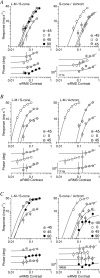Chromatic gain controls in visual cortical neurons
- PMID: 15888653
- PMCID: PMC6724777
- DOI: 10.1523/JNEUROSCI.5316-04.2005
Chromatic gain controls in visual cortical neurons
Abstract
Although the response of a neuron in the visual cortex generally grows nonlinearly with contrast, the spatial tuning of the cell remains stable. This is thought to reflect the activity of a contrast gain control ("normalization") that has very broad tuning on the relevant stimulus dimension. Contrast invariant tuning on a particular dimension is probably necessary for reliable representation of stimuli on that dimension. In the lateral geniculate nucleus (LGN), V1, and V2 of anesthetized macaque, we measured chromatic tuning of neurons at several contrasts to characterize the gain controls and identify cells that might be important for representing color. We estimated separately the chromatic signature of the linear receptive field and that of the gain control. In the LGN, we found normalization in magnocellular cells and cells receiving excitatory S-cone input but not in parvocellular cells or those receiving inhibitory S-cone input. We found normalization in all types of cortical neurons. Among cells that preferred achromatic modulation, or modulation along intermediate directions in color space (making them responsive to both achromatic and chromatic stimuli), normalization was driven by mechanisms tuned to a restricted range of directions in color space, close to achromatic. As a result, chromatic tuning varied with contrast. Among the relatively few cells that strongly preferred chromatic modulation, normalization was driven by mechanisms sensitive to modulation along all directions in color space, especially isoluminant. As a result, chromatic tuning changed little with contrast. To the extent that contrast invariant tuning is important in representing chromaticity, relatively few cortical neurons are involved.
Figures














References
-
- Abbott LF, Varela JA, Sen K, Nelson SB (1997) Synaptic depression and cortical gain control. Science 275: 220-224. - PubMed
-
- Albrecht DG, Hamilton DB (1982) Striate cortex of monkey and cat: contrast response function. J Neurophysiol 48: 217-237. - PubMed
-
- Benardete EA, Kaplan E (1997) The receptive field of the primate P retinal ganglion cell, II: nonlinear dynamics. Vis Neurosci 14: 187-205. - PubMed
-
- Benardete EA, Kaplan E, Knight BW (1992) Contrast gain control in the primate retina: P cells are not X-like, some M cells are. Vis Neurosci 8: 483-486. - PubMed
-
- Bonds AB (1989) Role of inhibition in the specification of orientation-selectivity of cells in the cat striate cortex. Vis Neurosci 2: 41-55. - PubMed
Publication types
MeSH terms
Grants and funding
LinkOut - more resources
Full Text Sources
Research Materials
